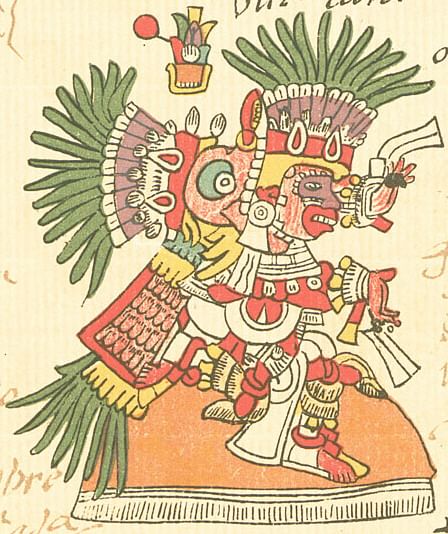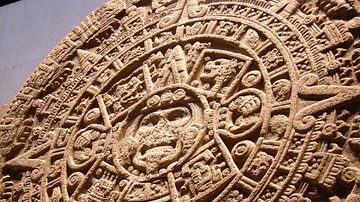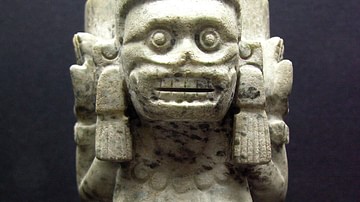
Tlahuizcalpantecuhtli, 'Dawn Lord,' was a Mesoamerican god who represented a menacing aspect of Venus, the morning star, and was one of the four gods which held up the sky. The people of the ancient Americas believed his rays could damage people, crops, and water sources. Tlahuizcalpantecuhtli played a key role in the Aztec creation myth and was 12th of the 13 Lords of the Day in the Aztec calendar.
Venus, the Morning Star
Tlahuizcalpantecuhtli (also spelt Tlauixcalpantecuhtli) represented the dual aspect of the planet Venus, known to the Mesoamericans as a bright star. Venus was especially important in the religious and agricultural calendar with its average 584-day cycle being carefully observed and precisely calculated. Even the architectural layout of cities, notably at Teotihuacan, Toltec Tollan, Maya Uxmal, and Chichen Itza, were built and aligned in accordance with the appearance of Venus at particular moments during its cycle. Mesoamerican astronomers recorded that the planet appears for 236 days as the morning star in the east, then sinks below the horizon for 90 days, and reappears for 250 days as the evening star in the west before disappearing again for 8 days before restarting the cycle over again. In actual fact, Venus can be seen with the naked eye for approximately 263 days in each spell, and it is not known quite why or how the ancient astronomers had arrived at their particular calculations.
Each aspect of Venus - morning and evening - was manifested in the form of two ancient Mesoamerican gods: the feathered-serpent Quetzalcoatl and his canine companion Xolotl. Quetzalcoatl represented Venus as the morning star, and Xolotl represented it as the evening star. In typical Mesoamerican duality, Tlahuizcalpantecuhtli was imagined as both and as the twin brother of Xolotl, and thus, above all, he represented the morning star aspect of Venus, which was considered a menacing one. Mesoamerican peoples considered the morning star particularly dangerous when it first appeared above the horizon each year (its heliacal rising). The rays, imagined in the form of atl-atl darts, were thought harmful to certain classes of people and to have a negative effect on maize and water.
The Skybearer
For ancient Mesoamericans, Tlahuizcalpantecuhtli was one of the four Skybearers, the gods who held up the sky. Tlahuizcalpantecuhtli was, thus, associated with the direction East and the year date Acatl. The Skybearers may have helped the cosmos by holding it up, but they had another, less charitable aspect during eclipses and the Aztec New Fire ceremony to renew the sun each 52 years. Then they joined the Tzitzimime, star demons which could descend, eat up humanity and destroy the world if the sun did not return.
The Aztec Creation Myth
In the Aztec creation myth Tlahuizcalpantecuhtli, both as himself and as an avatar of Quetzalcoatl, plays a crucial role. When the twin brothers Nanahuatzin and Tecuciztecatl sacrificed themselves at Teotihuacan to create the sun and moon of the 5th and last epoch of the Aztec cosmos they needed something or someone to kick-start themselves into motion and set off on their respective orbits. Nanahuatizin called for a blood sacrifice, but Tlahuizcalpantecuhtli was having none of it and, instead, threw an atl-atl dart at the sun. The throw missed, and Nanahuatzin returned the favour with more accuracy, striking Tlahuizcalpantecuhtli smack on the forehead, instantly turning him into stone. In this state, he is known as Itztlacoliuhqui, the god of cold, snow, and ice. The rest of the gods saw that only a sacrifice would set the sun and moon in motion, and so Quetzalcoatl removed their hearts for that purpose. The offering worked, and the 5th and final cosmos began.
Art & Architecture
Venus was often symbolised by a skull, and so too, representations of Tlahuizcalpantecuhtli depict him as a feathered serpent with a skull face. As the god was also closely associated with Mixcoatl, he sometimes wears the markings of that star god – white spots around a black field. Tlahuizcalpantecuhtli usually has five white spots representing stars, one on each cheek, and one on his forehead, nose and chin. One of the earliest examples of Tlahuizcalpantecuhtli in art is a rock painting at Ixtapantongo from around the 10th century CE.
Besides influencing the general town planning of many Mesoamerican cities, several specific buildings were aligned to the rise of Venus. Notable amongst these is the 24-room House of the Governors at Uxmal, constructed in the 10th century CE. Perhaps the most famous of all is the Caracol astronomical observatory at Chichen Itza which was constructed c. 800 CE.





